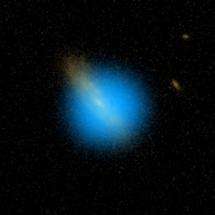Ultraviolet gives view inside real 'death star'

Scientists have, for the first time, observed a flash of ultraviolet light from within a dying star giving vital evidence of how stars turn into supernovae.
An international team, including nine scientists from Oxford University, combined data from ground-bound telescopes observing visible light from supernovae with data from a space telescope looking for an earlier peak in ultraviolet light from an associated dying star. They were able to spot telltale signs of the shockwave that forms within a star before it explodes into a supernova. A report of the work appears in this week’s Science.
‘Supernovae are huge stellar explosions that light up galaxies but often we have no idea which star has exploded,’ said Dr Kevin Schawinski of Oxford University’s Department of Physics. ‘The nature of such an explosion is that we can’t look inside it and it destroys almost all evidence of the original star – scientists have been trying to catch such an event happening for decades.’
Previously, scientists have observed stars nearing the end of their lives and supernova explosions and their afterglow, but have had little firm evidence of what happens in between. The new observations give a first glimpse of what happens inside a star during its final hours of life.
‘Out of all the supernovae we looked at we found one that was preceded by a dramatic ‘flash’ of ultraviolet light given off by a red super-giant star in a galaxy around a billion light years away. This flash occurred about two weeks before it was detected as a normal supernova,’ said Dr Stephen Justham of Oxford University’s Department of Physics.
‘We believe that this light, emanating from deep within the star, was generated after its core collapsed and compressed the gas surrounding it to around one million degrees Kelvin.’ Around four hours after this light was observed a shockwave from the collapsed core, travelling at 50 million kilometres an hour, would have hit the surface of the star and blown it apart. However, it was almost two weeks before the resulting fireball was spotted by supernova hunters using telescopes in Hawaii.
‘With this observation we have managed to peer inside one of the hundred billion stars in a galaxy and see what it is like at the very moment that it dies,’ said Dr Christian Wolf of Oxford University’s Department of Physics. ‘We’ve been extremely fortunate to capture this moment but this is just one event and, of course, we’d love to capture other similar events with different stars which could deliver many more surprises.’
Source: Oxford University




















